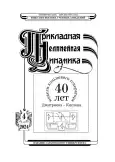Mathematical model for controlling brain neuroplasticity during neurofeedback
- Authors: Nuidel I.V.1, Kolosov A.V.1, Permiakov S.A.2, Egorov I.S2, Polevaia S.A.2, Yakhno V.G.1
-
Affiliations:
- Institute of Applied Physics of the Russian Academy of Sciences
- Lobachevsky State University of Nizhny Novgorod
- Issue: Vol 32, No 4 (2024)
- Pages: 472-491
- Section: Nonlinear dynamics and neuroscience
- URL: https://journals.rcsi.science/0869-6632/article/view/260945
- DOI: https://doi.org/10.18500/0869-6632-003109
- EDN: https://elibrary.ru/CAAKSH
- ID: 260945
Cite item
Full Text
Abstract
About the authors
Irina Vladimirovna Nuidel
Institute of Applied Physics of the Russian Academy of Sciences
ORCID iD: 0000-0003-1743-588X
SPIN-code: 9198-3639
Scopus Author ID: 6508304721
ResearcherId: J-3809-2015
ul. Ul'yanova, 46, Nizhny Novgorod , 603950, Russia
Alexey Vadimovich Kolosov
Institute of Applied Physics of the Russian Academy of Sciences
SPIN-code: 8407-4641
ul. Ul'yanova, 46, Nizhny Novgorod , 603950, Russia
Sergei Alexandrovich Permiakov
Lobachevsky State University of Nizhny Novgorod603950 Nizhny Novgorod, Gagarin Avenue, 23
Igor S Egorov
Lobachevsky State University of Nizhny Novgorod
ORCID iD: 0009-0000-0235-2964
603950 Nizhny Novgorod, Gagarin Avenue, 23
Sofia Alexandrovna Polevaia
Lobachevsky State University of Nizhny Novgorod
ORCID iD: 0000-0002-3896-787X
Scopus Author ID: 6504648647
ResearcherId: C-7512-2012
603950 Nizhny Novgorod, Gagarin Avenue, 23
Vladimir Grigorevich Yakhno
Institute of Applied Physics of the Russian Academy of Sciences
ORCID iD: 0000-0002-4689-472X
Scopus Author ID: 35554909600
ResearcherId: L-1813-2017
ul. Ul'yanova, 46, Nizhny Novgorod , 603950, Russia
References
- Савчук Л. В., Полевая С. А., Парин С. Б., Бондарь А. Т., Федотчев А. И. Резонансное сканирование и анализ электроэнцефалограммы при определении зрелости корковой ритмики у младших школьников // Биофизика. 2022. Т. 67, № 2. С. 354–361. doi: 10.31857/S000630 2922020181.
- Shaw C. A., McEachern J. C. Toward a Theory of Neuroplasticity. New York: Psychology Press, 2001. 468 p. doi: 10.4324/9780203759790.
- Kaczmarek B. L. Current views on neuroplasticity: what is new and what is old? // Acta Neuropsychologica. 2020. Vol. 18, no. 1. P. 1–14. doi: 10.5604/01.3001.0013.8808.
- Kaczmarek B. L., Markiewicz K. Brain plasticity and the idea of the functional system // Lurian Journal. 2021. Vol. 2, no. 2. P. 46–62. doi: 10.15826/Lurian.2021.2.2.3.
- Федотчев А. И., Парин С. Б., Громов К. Н., Савчук С. А., Полевая С. А. Комплексная обратная связь от биопотенциалов мозга и сердца в коррекции стресс-индуцированных состояний // Журнал высшей нервной деятельности им. Павлова. 2019. Т. 69, № 2. С. 187–193. doi: 10.1134/S0044467719020059.
- Федотчев А. И. Эффекты фотостимуляции, управляемой электроэнцефалограммой человека // Биофизика. 2019. Т. 64, № 2. С. 358–361. doi: 10.1134/S0006302919020157.
- Fedotchev A. I., Parin S. B., Polevaya S. A., Zemlianaia A. A. Human body rhythms in the development of non-invasive methods of closed-loop adaptive neurostimulation // J. Pers. Med. 2021. Vol. 11, no. 5. P. 437. doi: 10.3390/jpm11050437.
- Федотчев А. И., Земляная А. А., Савчук Л. В., Полевая С. А. Нейроинтерфейс с двойной обратной связью от ЭЭГ в коррекции стресс-вызванных расстройств // Современные технологии в медицине. 2019. Т. 11, № 1. С. 150–154. doi: 10.17691/stm2019.11.1.17.
- Федотчев А. И., Парин С. Б., Полевая С. А. Нейроинтерфейсы, управляемые биопотенциалами мозга и сердца, в коррекции стресс-вызванных расстройств // Вестник РФФИ. Общественные и гуманитарные науки. 2019. Т. 94, № 1. С. 144–152. doi: 10.22204/2587- 8956-2019-094-01-144-152.
- Федотчев А. И., Парин С. Б., Полевая С. А., Земляная А. А. Эффекты аудио - визуальной стимуляции, автоматически управляемой биопотенциалами мозга и сердца человека // Физиология человека. 2019. Т. 45, № 5. С. 75–79. doi: 10.1134/S0131164619050023.
- Coulter D. A. Thalamocortical Anatomy and Physiology. In: Engel Jr. J., Pedley T A. (eds). Epilepsy: A Comprehensive Textbook. Philadelphia: Lippincott-Raven, 1997. P. 341–351.
- Miranda R. A., Casebeer W. D., Hein A. M., Judy J. W., Krotkov E. P., Laabs T. L., Manzo J. E., Pankratz K. Z., Pratt G. A., Sanchez J. C., Weber D. J., Wheeler T. L., Ling G. S. F. Darpa-funded efforts in the development of novel brain–computer interface technologies // J. Neurosci. Methods. 2015. Vol. 244. P. 52–67. doi: 10.1016/j.jneumeth.2014.07.019.
- Федотчев А. И., Парин С. Б., Полевая С. А., Великова С. Д. Технологии «интерфейс мозг-компьютер» и нейробиоуправление: современное состояние и возможности клинического применения // Современные технологии в медицине. 2017. Т. 9, № 1. С. 175–184. doi: 10.17691/stm2017.9.1.22.
- Федотчев А. И., О Сан Джун, Бондарь А. Т., Семенов В. С. Современные возможности и подходы к активизации когнитивной деятельности и процессов обучения у человека: Монография. Пущино: ИБК РАН, 2017. 114 с.
- Fedotchev A. I., Parin S. B., Polevaya S. A. Adaptive neurostimulation methods in correcting posttraumatic stress disorder and professional burnout syndrome // Opera Medica et Physiologica. 2021. Vol. 8, no. 2. P. 68–74. doi: 10.24412/2500-2295-2021-2-68-74.
- Fedotchev A. I., Parin S. B., Polevaya S. A., Zemlianaia A. A. EG-based musical neurointerfaces in the correction of stress-induced states // Brain Comput Interfaces (Abingdon). 2022.Vol. 9, no. 1. P. 1–6. doi: 10.1080/2326263X.2021.1964874.
- Нуйдель И. В., Колосов А. В., Демарева В. А., Яхно В. Г. Применение феноменологической математической модели для воспроизведения эффекта взаимодействия эндогенных и экзогенных осцилляций при нейробиоуправлении // Современные технологии в медицине. 2019. Т. 11, № 1. С. 103–108. doi: 10.17691/stm2019.11.1.12.
- Федотчев А. И., Парин С. Б., Полевая С. А. Нейроинтерфейсы на основе эндогенных ритмов организма для оптимизации функционального состояния человека и его когнитивной реабилитации // Успехи физиологических наук. 2021. Т. 52, № 2. С. 83–92. doi: 10.31857/S030117 982102003X.
- Zhang Y., Guo D., Xu P., Zhang Y., Yao D. Robust frequency recognition for SSVEP-based BCI with temporally local multivariate synchronization index // Cogn. Neurodyn. 2016. Vol. 10, no. 6. P. 505–511. doi: 10.1007/s11571-016-9398-9.
- Кудряшов А. В., Яхно В. Г. Распространение областей повышенной импульсной активности в нейронной сети // Динамика биологических систем. 1978. Т. 2. С. 45–59.
- Yakhno Y. G. Basic models of hierarchy neuron-like systems and ways to analyse some of their complex reactions // Optical Memory and Neural Network. 1995. Vol. 4, no. 2. P. 145–155.
- Колосов А. В., Нуйдель И. В., Яхно В. Г. Исследование динамических режимов в математической модели элементарной таламокортикальной ячейки // Известия вузов. ПНД. 2016. Т. 24, № 5. С. 72–83. doi: 10.18500/0869-6632-2016-24-5-72-83.
Supplementary files










